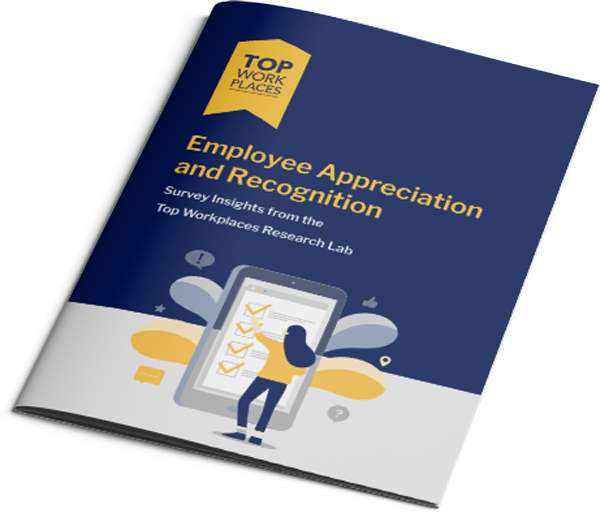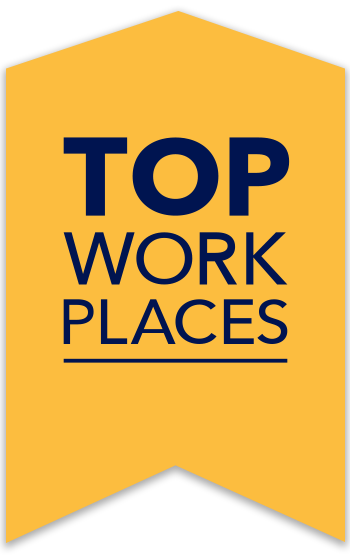
Create an appreciation culture with insights from HR professionals, Top Workplaces experts, and research-backed best practices.
Want to improve motivation, job satisfaction, morale, and employee retention? Research shows appreciation is one of the strongest drivers of employee engagement. When workers feel recognized, they feel seen, valued, and heard. They’re also motivated to bring their best to work every day.
Employee recognition is one of the qualities of a great workplace. Leaders of the nation’s Top Workplaces know this and intentionally build people-first cultures rich in employee appreciation.
Types of employee recognition
Employee recognition in the workplace includes both formal and informal forms of appreciation. Culture and tone are set at the top, so leaders are key to employee recognition.
It’s important to understand there isn’t a one-size-fits-all approach to appreciation. That’s why it’s critical to know what resonates most with employees. Efforts to nurture a culture of appreciation are only successful when they are authentic, coming from multiple sources and levels across the organization. This includes:
-
- Company-to-employee recognition
- Manager-to-employee recognition
- Peer-to-peer recognition
- Social recognition
- Top-down recognition
What makes a successful employee recognition program?
How employee recognition programs are implemented defines their success. Successful employee recognition programs use a personal approach to motivate people. And while appreciation can mean different things, it should always be sincere and genuine.
Capturing, strengthening, and echoing recognition from managers and peers engages employees and helps companies reinforce their goals and values. In the past, recognition programs included tactical gifts. Today, technology enables companies to amplify appreciation and promote social recognition.
What are the benefits of employee recognition?
Employee recognition in the workplace can increase employee engagement, boost morale, improve retention, and increase job satisfaction. Employee recognition can also:
- Drive motivation: Healthy competition inspires employees.
- Reinforce values: A greater connection to a shared purpose.
- Nurture trust: Employees feel valued and supported.
Done effectively, employee recognition leads to improved productivity, customer loyalty, sales, and more.
Learn more: Build an effective team
Employee recognition costs
Chances are, your organization is already spending money on employer recognition. Expenses such as team lunches, gift cards, and awards are employee recognition examples that may be allocated under a different category. Still, employee recognition is one of the simplest and least expensive ways to enrich the workplace experience.
Employee recognition examples and impact
Top Workplaces are the nation’s elite organizations that excel at employee recognition. Some recent examples from these award-winning companies include:
- CBIZ, one of the nation’s top accounting, tax, and advisory services providers, has a Total Rewards Employee Experience program. They aim to enhance the quality of peer and employee-supervisor relationships and create a sense of purpose in each employee’s work through recognition and appreciation.
- The ‘People Committee’ at The Gorilla Glue Company is dedicated to improving employee recognition through companywide events, cross-functional outings, and focus groups.
- Security awareness training company KnowBe4, as ‘Fun’ built into its company mission. One employee commented on a recent survey, “Leaders make me feel appreciated when they tell me how my contributions are making a positive impact.”
If you’re looking for employee recognition ideas, consider these best practices:
- Take every opportunity to give a sincere compliment or a simple “thank you.”
- Incorporate meaningful appreciation by recognizing employee, team, and company achievements.
- Talk to your employees about their strengths and individual growth to show you’re in touch with their achievements.
- Recognize special dates such as work anniversaries and birthdays.
- Highlight positive reviews that mention specific employees.
- Find ways to make it easy and quick for employees to express and broadcast their appreciation for others.
- Express the importance of appreciation during your onboarding efforts.
- Encourage and role model a culture of peer-to-peer appreciation.
- Give employees a chance to develop, demonstrating that you see their successes and believe they can accomplish even more.
What happens without an employee recognition program?
Failing to appreciate employees and incorporate employee recognition in your culture has a negative impact, especially in today’s competitive job market. Here are some things to watch for:
- Showing the wrong form of appreciation.
- Inconsistent employee recognition.
- Failing to show employee recognition during tough times.
- Employee recognition programs that feel fake or inauthentic.
Oftentimes, a lack of appreciation is why employees leave for better opportunities.
Get recognized for your employee recognition program
Securing workplace culture awards gives your organization a reason to celebrate and boost morale. But it also brings additional significant advantages, including valuable credibility, increased media exposure, and an expanded talent reach.
Here, we highlight several Top Workplaces companies with the best employee recognition programs. Visit their profiles to see how they use employer-of-choice awards to build a brand that attracts top talent, reduces hiring time, and draws new business.
Read more: Why Employer Recognition Awards Matter
If your company believes in the power of a people-first culture that prioritizes employee appreciation, get recognized for it! Top Workplaces is the nation’s leading employer recognition program, offering awards in 60+ regional markets plus national honors for culture and industry excellence. To participate, begin by nominating your organization here.

